PRM701 Project Management Principles: Quality Control, Risk Mitigation
VerifiedAdded on 2023/06/11
|6
|1058
|147
Report
AI Summary
This report provides an analysis of quality control measures and risk management processes in project management, referencing the PMBOK processes and AS/NZS ISO31000:2009. It explains how quality control enhances project scope achievement, customer satisfaction, and product/service development by reducing rework and improving internal communication. The report further explores risk management, identifying potential risks such as project delays, budget overruns, unskilled labor, and communication gaps, and emphasizes the importance of proactive risk management throughout the project lifecycle to ensure successful project completion within the scheduled timeline and budget. The student document is available on Desklib, a platform offering study tools for students.
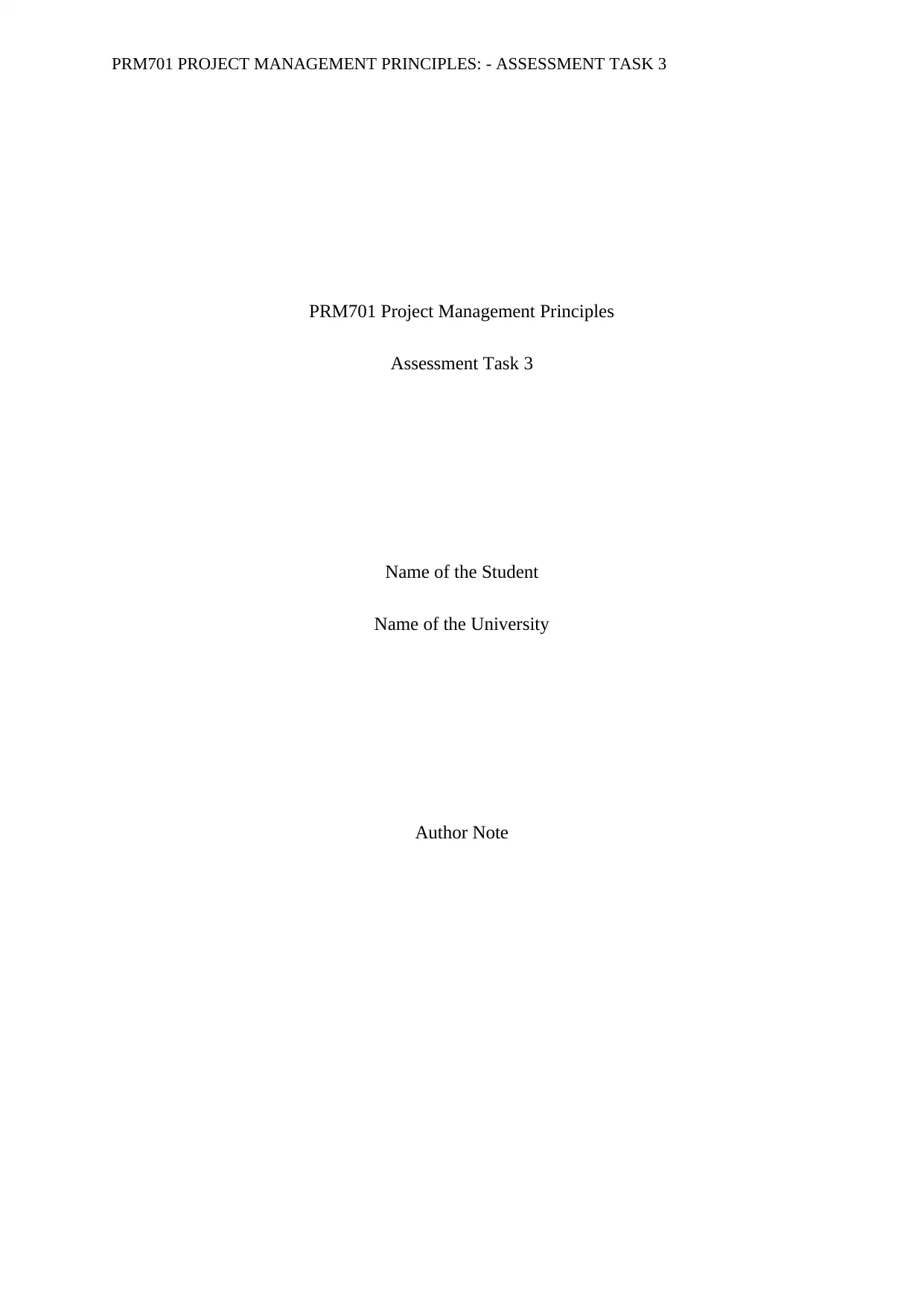
PRM701 PROJECT MANAGEMENT PRINCIPLES: - ASSESSMENT TASK 3
PRM701 Project Management Principles
Assessment Task 3
Name of the Student
Name of the University
Author Note
PRM701 Project Management Principles
Assessment Task 3
Name of the Student
Name of the University
Author Note
Paraphrase This Document
Need a fresh take? Get an instant paraphrase of this document with our AI Paraphraser
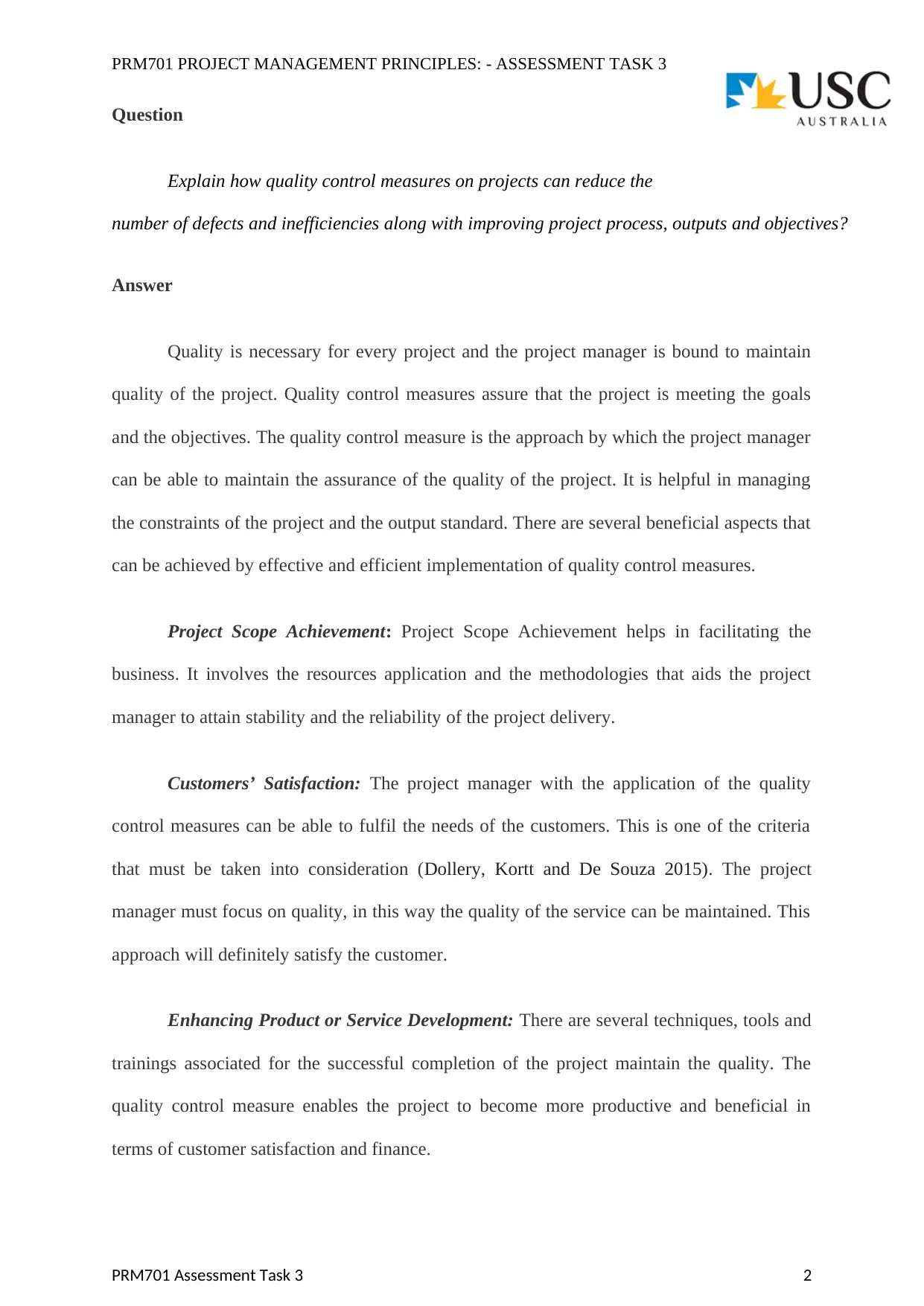
PRM701 PROJECT MANAGEMENT PRINCIPLES: - ASSESSMENT TASK 3
Question
Explain how quality control measures on projects can reduce the
number of defects and inefficiencies along with improving project process, outputs and objectives?
Answer
Quality is necessary for every project and the project manager is bound to maintain
quality of the project. Quality control measures assure that the project is meeting the goals
and the objectives. The quality control measure is the approach by which the project manager
can be able to maintain the assurance of the quality of the project. It is helpful in managing
the constraints of the project and the output standard. There are several beneficial aspects that
can be achieved by effective and efficient implementation of quality control measures.
Project Scope Achievement: Project Scope Achievement helps in facilitating the
business. It involves the resources application and the methodologies that aids the project
manager to attain stability and the reliability of the project delivery.
Customers’ Satisfaction: The project manager with the application of the quality
control measures can be able to fulfil the needs of the customers. This is one of the criteria
that must be taken into consideration (Dollery, Kortt and De Souza 2015). The project
manager must focus on quality, in this way the quality of the service can be maintained. This
approach will definitely satisfy the customer.
Enhancing Product or Service Development: There are several techniques, tools and
trainings associated for the successful completion of the project maintain the quality. The
quality control measure enables the project to become more productive and beneficial in
terms of customer satisfaction and finance.
PRM701 Assessment Task 3 2
Question
Explain how quality control measures on projects can reduce the
number of defects and inefficiencies along with improving project process, outputs and objectives?
Answer
Quality is necessary for every project and the project manager is bound to maintain
quality of the project. Quality control measures assure that the project is meeting the goals
and the objectives. The quality control measure is the approach by which the project manager
can be able to maintain the assurance of the quality of the project. It is helpful in managing
the constraints of the project and the output standard. There are several beneficial aspects that
can be achieved by effective and efficient implementation of quality control measures.
Project Scope Achievement: Project Scope Achievement helps in facilitating the
business. It involves the resources application and the methodologies that aids the project
manager to attain stability and the reliability of the project delivery.
Customers’ Satisfaction: The project manager with the application of the quality
control measures can be able to fulfil the needs of the customers. This is one of the criteria
that must be taken into consideration (Dollery, Kortt and De Souza 2015). The project
manager must focus on quality, in this way the quality of the service can be maintained. This
approach will definitely satisfy the customer.
Enhancing Product or Service Development: There are several techniques, tools and
trainings associated for the successful completion of the project maintain the quality. The
quality control measure enables the project to become more productive and beneficial in
terms of customer satisfaction and finance.
PRM701 Assessment Task 3 2
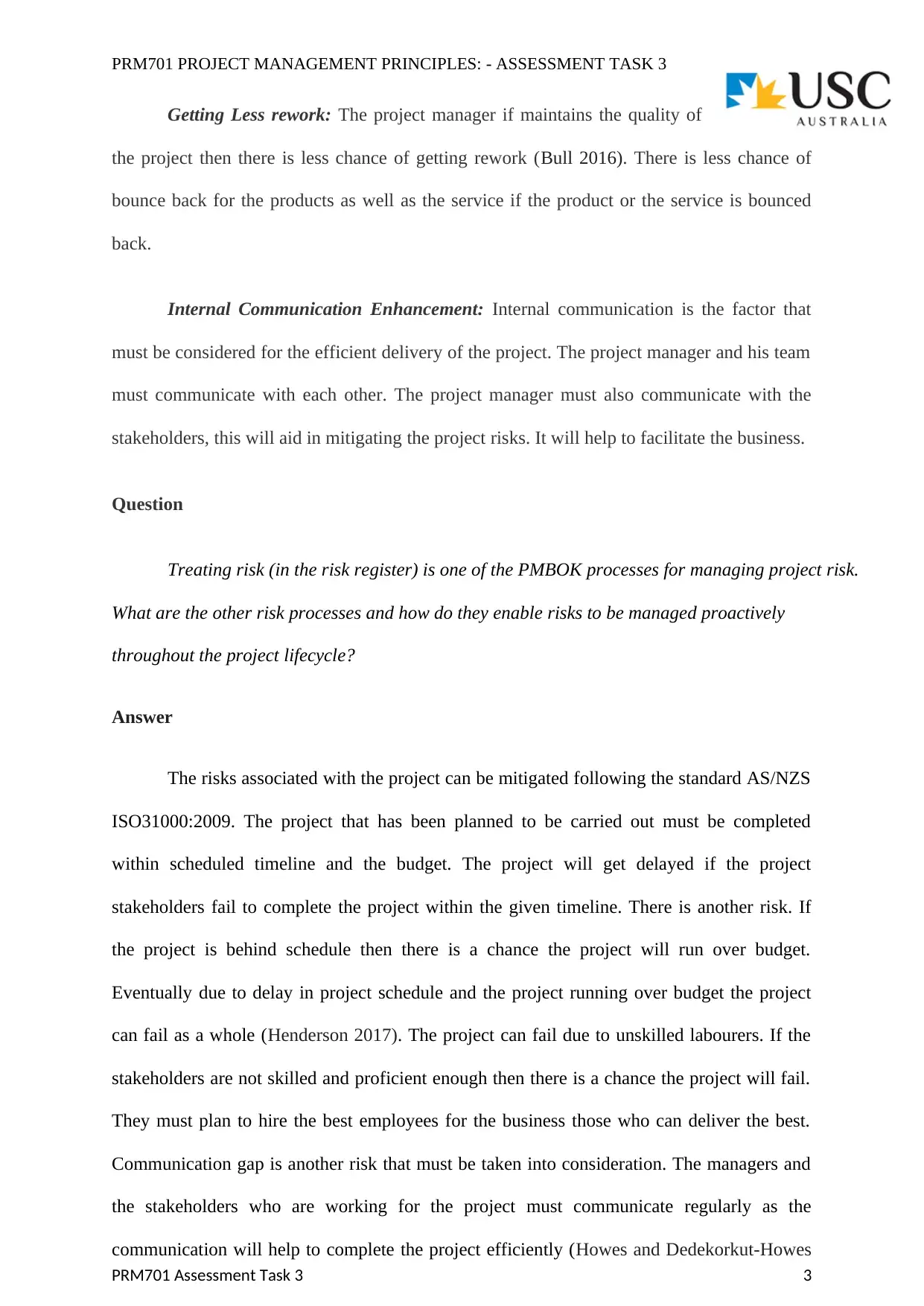
PRM701 PROJECT MANAGEMENT PRINCIPLES: - ASSESSMENT TASK 3
Getting Less rework: The project manager if maintains the quality of
the project then there is less chance of getting rework (Bull 2016). There is less chance of
bounce back for the products as well as the service if the product or the service is bounced
back.
Internal Communication Enhancement: Internal communication is the factor that
must be considered for the efficient delivery of the project. The project manager and his team
must communicate with each other. The project manager must also communicate with the
stakeholders, this will aid in mitigating the project risks. It will help to facilitate the business.
Question
Treating risk (in the risk register) is one of the PMBOK processes for managing project risk.
What are the other risk processes and how do they enable risks to be managed proactively
throughout the project lifecycle?
Answer
The risks associated with the project can be mitigated following the standard AS/NZS
ISO31000:2009. The project that has been planned to be carried out must be completed
within scheduled timeline and the budget. The project will get delayed if the project
stakeholders fail to complete the project within the given timeline. There is another risk. If
the project is behind schedule then there is a chance the project will run over budget.
Eventually due to delay in project schedule and the project running over budget the project
can fail as a whole (Henderson 2017). The project can fail due to unskilled labourers. If the
stakeholders are not skilled and proficient enough then there is a chance the project will fail.
They must plan to hire the best employees for the business those who can deliver the best.
Communication gap is another risk that must be taken into consideration. The managers and
the stakeholders who are working for the project must communicate regularly as the
communication will help to complete the project efficiently (Howes and Dedekorkut-Howes
PRM701 Assessment Task 3 3
Getting Less rework: The project manager if maintains the quality of
the project then there is less chance of getting rework (Bull 2016). There is less chance of
bounce back for the products as well as the service if the product or the service is bounced
back.
Internal Communication Enhancement: Internal communication is the factor that
must be considered for the efficient delivery of the project. The project manager and his team
must communicate with each other. The project manager must also communicate with the
stakeholders, this will aid in mitigating the project risks. It will help to facilitate the business.
Question
Treating risk (in the risk register) is one of the PMBOK processes for managing project risk.
What are the other risk processes and how do they enable risks to be managed proactively
throughout the project lifecycle?
Answer
The risks associated with the project can be mitigated following the standard AS/NZS
ISO31000:2009. The project that has been planned to be carried out must be completed
within scheduled timeline and the budget. The project will get delayed if the project
stakeholders fail to complete the project within the given timeline. There is another risk. If
the project is behind schedule then there is a chance the project will run over budget.
Eventually due to delay in project schedule and the project running over budget the project
can fail as a whole (Henderson 2017). The project can fail due to unskilled labourers. If the
stakeholders are not skilled and proficient enough then there is a chance the project will fail.
They must plan to hire the best employees for the business those who can deliver the best.
Communication gap is another risk that must be taken into consideration. The managers and
the stakeholders who are working for the project must communicate regularly as the
communication will help to complete the project efficiently (Howes and Dedekorkut-Howes
PRM701 Assessment Task 3 3
⊘ This is a preview!⊘
Do you want full access?
Subscribe today to unlock all pages.

Trusted by 1+ million students worldwide
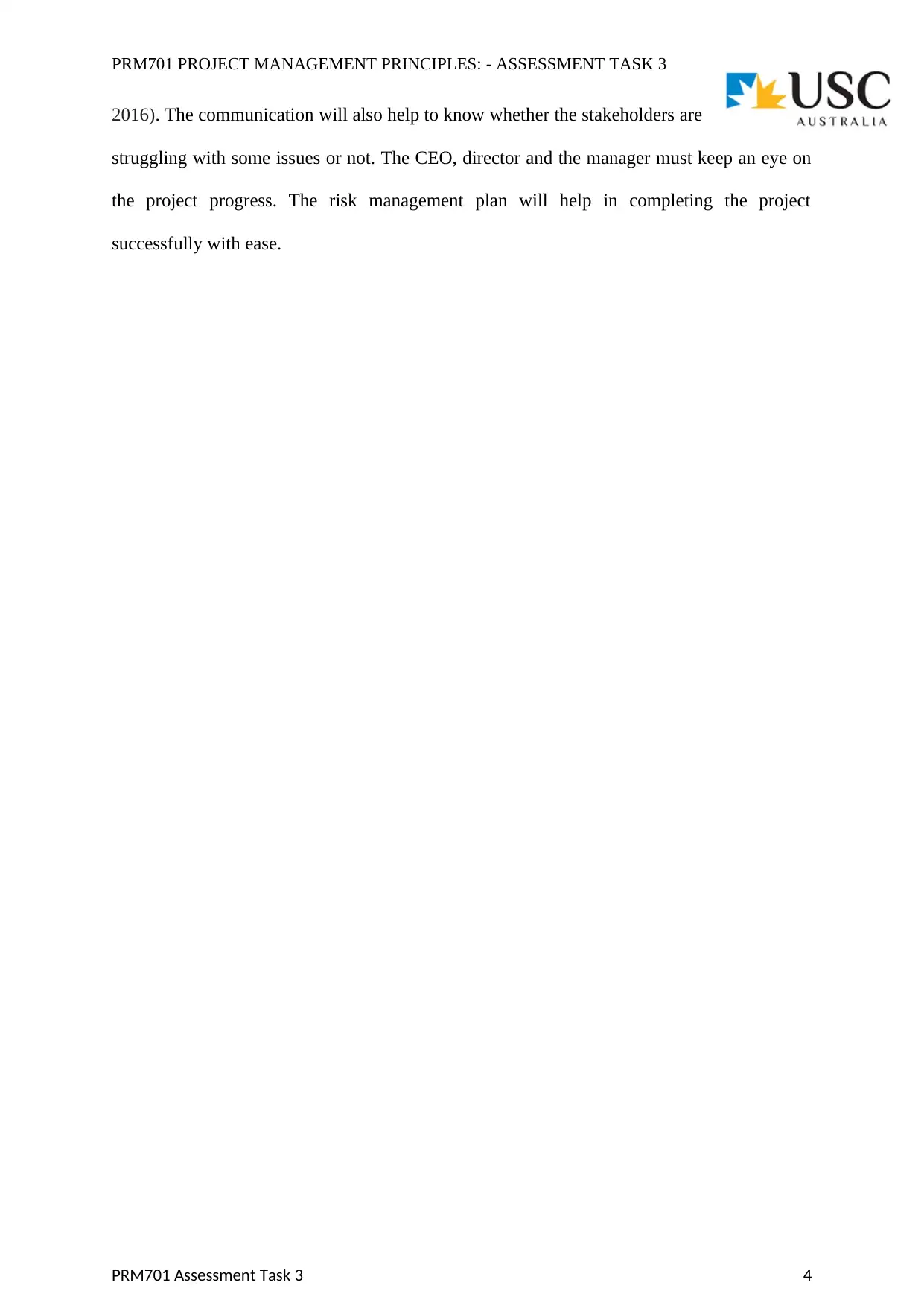
PRM701 PROJECT MANAGEMENT PRINCIPLES: - ASSESSMENT TASK 3
2016). The communication will also help to know whether the stakeholders are
struggling with some issues or not. The CEO, director and the manager must keep an eye on
the project progress. The risk management plan will help in completing the project
successfully with ease.
PRM701 Assessment Task 3 4
2016). The communication will also help to know whether the stakeholders are
struggling with some issues or not. The CEO, director and the manager must keep an eye on
the project progress. The risk management plan will help in completing the project
successfully with ease.
PRM701 Assessment Task 3 4
Paraphrase This Document
Need a fresh take? Get an instant paraphrase of this document with our AI Paraphraser
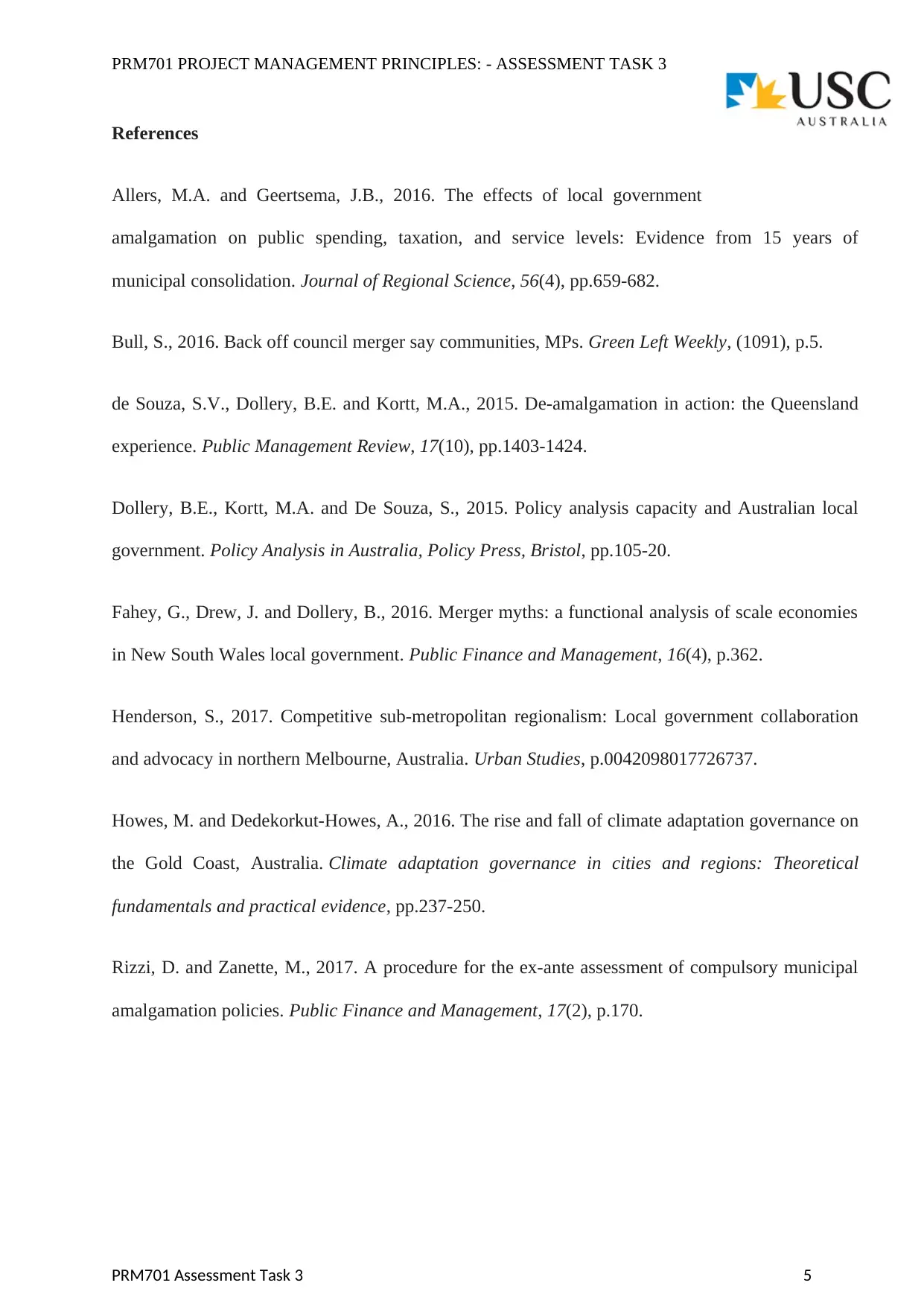
PRM701 PROJECT MANAGEMENT PRINCIPLES: - ASSESSMENT TASK 3
References
Allers, M.A. and Geertsema, J.B., 2016. The effects of local government
amalgamation on public spending, taxation, and service levels: Evidence from 15 years of
municipal consolidation. Journal of Regional Science, 56(4), pp.659-682.
Bull, S., 2016. Back off council merger say communities, MPs. Green Left Weekly, (1091), p.5.
de Souza, S.V., Dollery, B.E. and Kortt, M.A., 2015. De-amalgamation in action: the Queensland
experience. Public Management Review, 17(10), pp.1403-1424.
Dollery, B.E., Kortt, M.A. and De Souza, S., 2015. Policy analysis capacity and Australian local
government. Policy Analysis in Australia, Policy Press, Bristol, pp.105-20.
Fahey, G., Drew, J. and Dollery, B., 2016. Merger myths: a functional analysis of scale economies
in New South Wales local government. Public Finance and Management, 16(4), p.362.
Henderson, S., 2017. Competitive sub-metropolitan regionalism: Local government collaboration
and advocacy in northern Melbourne, Australia. Urban Studies, p.0042098017726737.
Howes, M. and Dedekorkut-Howes, A., 2016. The rise and fall of climate adaptation governance on
the Gold Coast, Australia. Climate adaptation governance in cities and regions: Theoretical
fundamentals and practical evidence, pp.237-250.
Rizzi, D. and Zanette, M., 2017. A procedure for the ex-ante assessment of compulsory municipal
amalgamation policies. Public Finance and Management, 17(2), p.170.
PRM701 Assessment Task 3 5
References
Allers, M.A. and Geertsema, J.B., 2016. The effects of local government
amalgamation on public spending, taxation, and service levels: Evidence from 15 years of
municipal consolidation. Journal of Regional Science, 56(4), pp.659-682.
Bull, S., 2016. Back off council merger say communities, MPs. Green Left Weekly, (1091), p.5.
de Souza, S.V., Dollery, B.E. and Kortt, M.A., 2015. De-amalgamation in action: the Queensland
experience. Public Management Review, 17(10), pp.1403-1424.
Dollery, B.E., Kortt, M.A. and De Souza, S., 2015. Policy analysis capacity and Australian local
government. Policy Analysis in Australia, Policy Press, Bristol, pp.105-20.
Fahey, G., Drew, J. and Dollery, B., 2016. Merger myths: a functional analysis of scale economies
in New South Wales local government. Public Finance and Management, 16(4), p.362.
Henderson, S., 2017. Competitive sub-metropolitan regionalism: Local government collaboration
and advocacy in northern Melbourne, Australia. Urban Studies, p.0042098017726737.
Howes, M. and Dedekorkut-Howes, A., 2016. The rise and fall of climate adaptation governance on
the Gold Coast, Australia. Climate adaptation governance in cities and regions: Theoretical
fundamentals and practical evidence, pp.237-250.
Rizzi, D. and Zanette, M., 2017. A procedure for the ex-ante assessment of compulsory municipal
amalgamation policies. Public Finance and Management, 17(2), p.170.
PRM701 Assessment Task 3 5
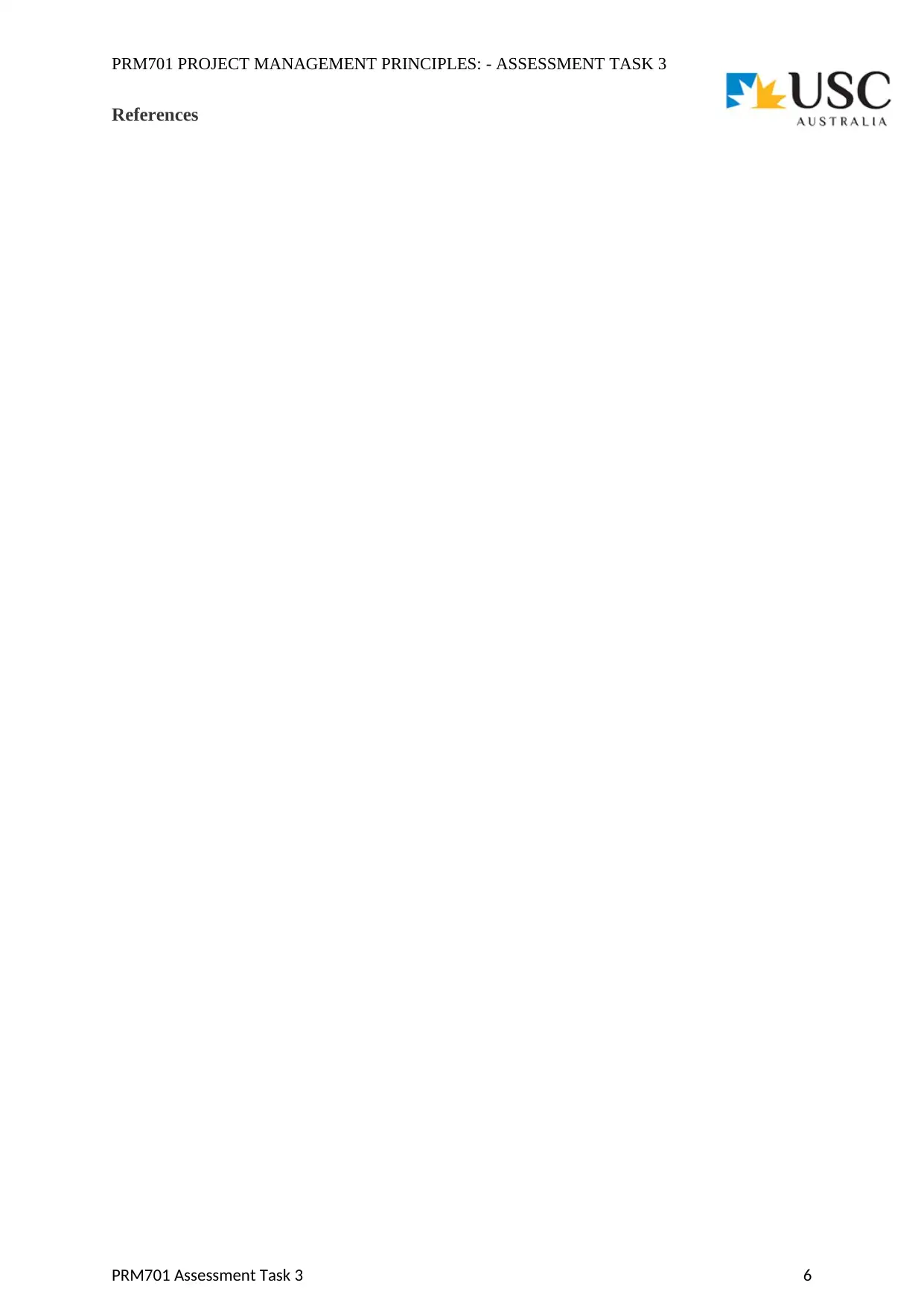
PRM701 PROJECT MANAGEMENT PRINCIPLES: - ASSESSMENT TASK 3
References
PRM701 Assessment Task 3 6
References
PRM701 Assessment Task 3 6
⊘ This is a preview!⊘
Do you want full access?
Subscribe today to unlock all pages.

Trusted by 1+ million students worldwide
1 out of 6
Related Documents
Your All-in-One AI-Powered Toolkit for Academic Success.
+13062052269
info@desklib.com
Available 24*7 on WhatsApp / Email
![[object Object]](/_next/static/media/star-bottom.7253800d.svg)
Unlock your academic potential
Copyright © 2020–2025 A2Z Services. All Rights Reserved. Developed and managed by ZUCOL.


